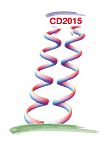Speaker
Xu Feng
(Columbia University, New York)
Description
The rare kaon decays, K → πν¯ν, have attracted increasing interest during the past few
decades. As flavor changing neutral current processes, these decays are highly suppressed in the standard model and thus provide ideal probes for the observation of new physics effects. As second-order weak interactions, the ultra-rare decays K → πν¯ν represent a significant challenge in experiments. After 40 years search, only 7 K+ → π+ ν¯ν events have been collected in BNL E787 and E949 by 2008 [1]. A new generation of experiment, NA62 in CERN [2], aims at an observation of O(100) events and a 10%-precision measurement of the branching ratio in two years. The standard model predictions of K → πν¯ν branching ratios are dominated by short-distance contributions. The long-distance contributions below the energy scale of the charm quark mass are safely neglected in KL → π0 ν¯ν and are expected to be small in K+ → π+ ν¯ν. Although small, the long-distance contributions estimated from a phenomenological ansatz involving both chiral perturbation theory and operator production expansion enhance the branching ratio by 6% [3]. Recognizing that the standard model predictions will soon be confronted with new experiment results, a lattice QCD calculation of the long-distance contribution to K+ → π+ ν¯ν is important. In this talk I will present an exploratory calculation of the long-distance contributions to the K+ → π+ ν¯ν decay amplitude from first principles using lattice QCD.
References
1. A. Artamonovet al. (E949 Collaboration), Phys. Rev. Lett. 79, 2204 (1997).
2. M. Moulson (NA62 Collaboration), (2013), arXiv:1310.7816.
3. G. Isidori, F. Mescia, and C. Smith, Nucl. Phys. B 718, 319 (2005).
Primary author
Xu Feng
(Columbia University, New York)
Co-authors
Dr
Amarjit Soni
(Brookhaven National Laboratory)
Dr
Andreas Juettner
(Univ. of Southampton)
Mr
Andrew Lawson
(University of Southampton)
Dr
Antonin Portelli
(University of Southampton)
Dr
Christoph Lehner
(Brookhaven National Laboratory)
Prof.
Christopher Sachrajda
(University of Southampton)
Prof.
Norman Christ
(Columbia University)

